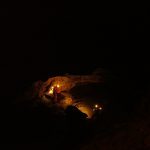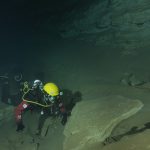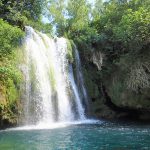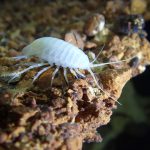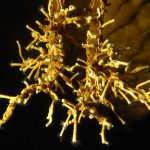Caves near the Miljacka waterfall
Along the canyon section of the Krka River, the following caves are found on the right bank of the Krka River: Miljacka I-V cave system, Miljacka II, Miljacka III (cave under the falls), Miljacka IV (cave by the Miljacki mill), Miljacka VI and VII.
The Miljacka I-V cave system is the only cave system in Krka National Park. It is situated on the right bank, upstream of the Miljacki water mills, at an elevation of 102 metres. The total length of the investigated part of the system is 2456 metres, with a depth of 33 metres and elevation difference of 44 metres. The system includes the unique area of two former caves, Miljacka I and Miljacka V, which were connected during research conducted in 2001 by a dry channel and in 2017 by a submerged channel. The cave system has two entrances, just 20 metres apart, and 10 metres above the water level of the Krka River. During periods of high waters, the cave entrances are submerged, and water springs from them. The cave system was formed within Promina deposits on a tectonic fault extending in the direction NW-SE. The highest part of the grand cavern, situated 50 metres from the first entrance, is above the level of the main torrential flow, and its stalactites and stalagmites are well preserved. In the lower areas, the stalagmites are eroded due to occasional flooding of the structure.
The cave Miljacka IV (cave near the Miljacki mill) is situated within the plant building of the old water main system on the right bank, upstream of the Miljacka Hydroelectric plant, at an elevation of 78 metres. The length of the investigated part of the cave is 302.9 metres, with a depth of 8 metres and elevation difference of 10 metres. The cave has two entrances: a terrestrial and aquatic entrance. The aquatic entrance can only be accessed by diving. A concrete wall with an access shaft is found at the terrestrial entrance. In the cavern at the entrance of the cave, there is a drystone wall. A layer of coal is visible at several sites in the small chamber.
Due to the strong influence on the cave and water flow within it, the temperature in the cave varies substantially through the year. The difference between the highest and lowest measured temperature is 10.9°C, while the average temperature is about 14.5°C.
The Miljacka IV cave is habitat for 29 taxa, including snails (Gastropoda), spiders (Araneae), pseudoscorpions (Pseudoscorpiones), harvestmen (Opiliones), mites (Acari), isopods (Isopoda), amphipods (Amphipoda), decapods (Decapoda), centipedes (Chilopoda), millipedes (Diplopoda), springtails (Collembola), bristletails (Diplura), beetles (Coleoptera), booklice (Psocoptera), grasshoppers, crickets (Orthoptera), and butterflies and moths (Lepidoptera). Among them are several species that are endemic to the Dinarides mountain range and Croatia.
The cave Miljacka VI is found on the left bank, along the stream that drains into the Krka River 50 metres downstream from the waterfall. It is completely formed in a fossil travertine barrier. The cave is a small and simple speleological structure, without any opportunities for further research. It is just 5.5 metres long and 2 metres deep. It has no active water flow, though occasionally water percolates from the layers above the cave to form speleothems. In the geological past, it likely belonged to a larger cave system, but the erosion action of the river, deepening of the riverbed and loss of material denuded the once larger structure. The stalactites and stalagmites inside indicate a longer period with a dry atmosphere, and the fossil stage of development of the structure suitable for the growth of speleothems. It can be assumed that this cave was once a much larger structure.
The cave Miljacka VII is just 15 metres from the cave Miljacka VI. This is a simple speleological structure formed in fossil travertine. It is 9 metres long and 2 metres deep. The structure was formed in the horizontal and subhorizontal layers, which determined its general morphology. The cave has no active water flow. Deeper sections of the cave contain numerous speleothems (stalactites, stalagmites, columns, other forms). Like in the cave Miljacka VI, these indicate a long period of the fossil phase suitable for their growth, and it is likely that in the geological past, this was a larger speleological system, that was possibly connected with other speleological structures in the canyon.
The cave Miljacka II is the longest speleological structure in Krka National Park, and features a wide diversity of cave fauna, while Miljacka III is interesting hydrologically, as in this part, the water flows at two levels – both through the cave and on the surface, in the Krka riverbed.
The cave springs in the area of the Miljacka waterfall are habitat to the only true stygobiont vertebrate species (amphibian) in Europe, the olm (Proteus anguinus), an endemic of the Dinaric karst.
Photo: Vedran Jalžić



